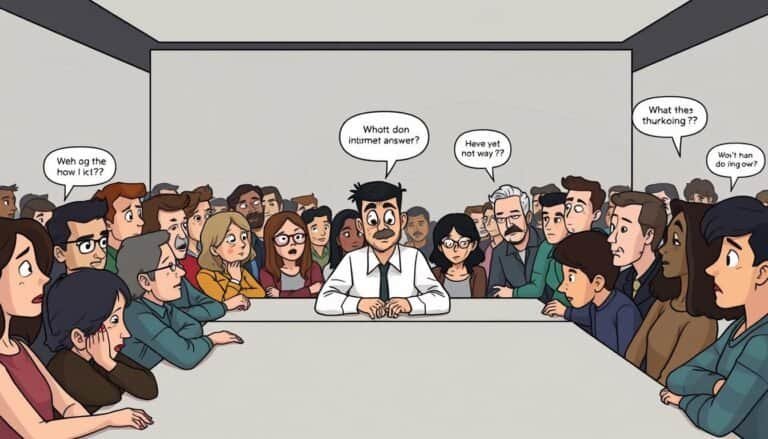Leveraging the Scarcity Principle in Marketing
Have you ever seen people buy products quickly because they’re labeled “limited edition” or “only a few left”? This is thanks to the Scarcity Principle, a key psychological trigger. It affects how people make choices.
Big companies like Apple, Nike, and Hermès use scarcity marketing to make products more appealing. They create a sense of urgency to buy now. This makes customers act fast, often leading to quick sales.
Let’s dive into how the Scarcity Principle works. We’ll see why it’s so effective in today’s market. We’ll also look at why the fear of missing out (FOMO) affects consumer choices so much.
Key Takeaways
- The Scarcity Principle drives urgency and boosts consumer demand.
- Successful brands leverage scarcity marketing for limited product releases.
- Psychological scarcity impacts customer behavior significantly.
- Flash sales and low-stock notifications increase consumer urgency.
- Exclusivity enhances product desirability among consumers.
- Understanding scarcity can improve marketing strategies for businesses.
Understanding the Scarcity Principle
The Scarcity Principle is key in how people make buying choices. It says that when a product is harder to find, people think it’s more valuable. This idea changes how people see products and often makes them want more when it’s scarce.
Knowing where it comes from and why it works can help with marketing.
Definition and Origin of the Scarcity Principle
The Scarcity Principle states that if people think a product is rare, they want it more. This makes them buy it faster. Brands use *limited-time offers* to make this happen, pushing customers to buy before it’s too late.
Good marketing is key to making this work. It builds trust and makes things clear to potential buyers.
The Role of Dr. Robert Cialdini in Marketing Psychology
Dr. Robert Cialdini is a big name in marketing psychology. He’s studied how scarcity affects what people buy. He found that scarcity makes people worry about missing out, or FOMO, which makes them choose certain products over others.
He says using scarcity well can increase demand and get people talking about a product. Many brands use this idea, combining it with social proof to make their marketing stronger.
The Psychology Behind Scarcity in Marketing
Scarcity plays a big role in how we act as consumers. It’s the idea that things we think are rare are more valuable. This idea affects what we choose to buy and makes us want to act fast. Knowing about this can help marketers make their products more appealing and keep customers interested.
The Impact of Psychological Scarcity on Consumer Behavior
Psychological scarcity changes how we shop. When we know a product is rare, we act differently. We rush to buy it, fearing we’ll miss out. This rush can lead to quick, maybe not-so-thoughtful decisions.
Marketers use this by offering limited-time deals and showing low stock. This makes us want to buy now to avoid regret later.
How Scarcity Creates Urgency to Buy
Marketing uses scarcity to make us feel like we must act fast. Flash sales, countdown timers, and showing low stock are common online. For example, Supreme releases limited items, making them seem exclusive.
This makes us buy quickly before they’re gone. Events like Amazon’s Prime Day also show us spending more than usual.
| Scarcity Technique | Consumer Reaction | Industry Example |
|---|---|---|
| Flash Sales | Immediate purchases due to urgency | Amazon Lightning Deals |
| Limited Editions | Perceived value increases | Supreme product drops |
| Countdown Timers | Encourages quick decision-making | Various e-commerce platforms |
| Stock Level Indicators | Stimulates urgency and fear of loss | Airlines and hotel bookings |
Companies use scarcity to make us feel strong emotions, which increases demand. They need to be careful not to lose our trust while doing this.
The Scarcity Principle in Marketing
Marketers know the power of the Scarcity Principle. It makes consumers act fast by creating urgency. This approach boosts engagement and sales. Many businesses have seen its success in their campaigns.
Exploring the Strategic Use of Scarcity in Campaigns
Scarcity marketing makes people buy quicker. Marketers use limited-time offers and exclusive deals. For instance, countdown timers on websites push for immediate buys.
Booking.com shows hotel rooms running out to create urgency. TigerDirect.com and Amazon use daily deals to speed up sales.
Case Studies of Successful Scarcity Marketing
Many brands have used scarcity to great effect. Nike’s SNKRs app releases limited shoes, creating a buzz. Starbucks’s Unicorn Frappuccino was a hit because it was only available for a short time.
In tech, OnePlus and Mailbox limit access to their products, making them more exclusive. Quibb is selective about who joins, adding to its appeal. These strategies show how scarcity boosts demand and brand value.
| Brand | Scarcity Tactic | Outcome |
|---|---|---|
| Nike | Limited-stock footwear release | Increased demand and customer engagement |
| Starbucks | Limited-time Unicorn Frappuccino | Created buzz and drove impulse buys |
| Booking.com | Display of last available rooms | Enhancement of urgency, boosting bookings |
| OnePlus | Invite-only phone sales | Generated exclusivity and high product demand |
| Mailbox | In-app waiting line | Created anticipation for app launch |
These examples show how scarcity marketing boosts sales and builds relationships with customers. Limited access often means more value to the customer.
Scarcity Strategies for Businesses
Using effective scarcity strategies can boost a business’s marketing. These strategies create a sense of urgency and exclusivity. This can make customers more likely to act and increase sales. Here are some key methods to use these principles.
Implementing Limited-Time Offers
Limited-time offers make customers feel they must act fast. This urgency can lead to quicker decisions. Studies show that these offers can increase sales and revenue by making customers rush to buy before it’s too late.
Creating Exclusivity with Limited Editions
Launching limited editions taps into the human desire for rare items. When products are seen as exclusive, people want them more. This strategy builds interest and makes customers want to be among the few who get them, leading to more sales.
Utilizing Pre-Order Options to Gauge Demand
Pre-order options let businesses see how much people want a product before it’s released. This approach creates excitement and connects with potential customers early. Offering early access can build anticipation and help ensure a successful launch, using scarcity to your advantage.
| Scarcity Strategy | Purpose | Potential Benefits |
|---|---|---|
| Limited-Time Offers | Create urgency to prompt quick purchases | Increased conversions and revenue |
| Limited Editions | Enhance exclusivity and desirability | Heightened interest and purchase rates |
| Pre-Order Options | Gauge demand before product launch | Build anticipation and secure early sales |
These strategies not only boost sales but also make customers feel special. By making offers seem exclusive and urgent, businesses can do better in their marketing. Companies that use these methods often see more success.
Scarcity in Advertising: Techniques and Tactics
In the world of ads, using scarcity is a strong way to grab customers’ attention. Ads show how much is left, making people act fast. Flash sales are key here, offering a short chance to buy that makes people buy quickly.
Highlighting Remaining Stock Levels
Notifying customers about low stock is a common method in ads. Telling people a popular item is almost gone creates urgency. This approach works well, with 68% of millennials buying more because they don’t want to miss out.
Many make a quick decision, buying within 24 hours of seeing the alert.
Using Flash Sales to Drive Rapid Purchases
Flash sales tap into consumers’ desire for quick action, which has grown by 38% in five years thanks to tech. These sales offer discounts or special deals, making people act fast. For example, online stores with countdown timers see big sales jumps.
One store saw a 226% increase in sales by offering next-day shipping. This shows how scarcity can really boost sales.
| Tactic | Description | Impact |
|---|---|---|
| Limited-Products Tactic | Informing customers of low stock on popular items. | Increases urgency and boosts purchase likelihood. |
| Flash Sales | Short-term discounts prompting rapid purchases. | Creates urgency, leading to higher conversions. |
| Limited-Time Offers | Seasonal promotions that encourage quick buys. | Enhances perceived value and can increase average order size. |
| Urgency Marketing | Strategies utilizing a fear of missing out. | Prompts faster consumer action and decision-making. |
Scarcity Effect: How It Influences Customer Decisions
The scarcity effect is key in how people make choices. It’s linked to the law of supply and demand. When things are less available, they seem more valuable and make customers act faster. Marketers need to understand this to improve their plans.
The Law of Supply and Demand in Action
Supply and demand greatly affect how people shop. When there’s less of a product, people want it more. This is seen in things like limited-edition items and even digital currencies like Bitcoin, which has only 21 million coins. This makes prices go up.
Marketers use scarcity to make products seem more valuable and urgent. This makes customers want them more.
Consumer Behavior Changes Under Scarcity
Scarcity changes how people see and value products. When there’s less of something, people feel they can’t choose freely. This makes them want it even more.
This makes them think the product is worth more. It also makes buyers compete more, especially in auctions where they bid higher because they want it so much.
- Lost freedom increases desire.
- Scarcity enhances value attribution.
- Competition drives demand in limited situations.
Marketers can use these facts to improve their products. Knowing how scarcity affects people helps brands make customers think before they buy. By watching how scarcity works, companies can make their marketing better. They can balance how much they offer and how they make people feel.
| Factor | Impact of Scarcity |
|---|---|
| Supply | Low supply boosts demand and price |
| Perceived Value | Scarcity enhances consumers’ value perception |
| Emotional Response | Triggers urgency and impulsive buying |
| Competition | Increases buying intensity in limited scenarios |
Knowing these things helps businesses make better marketing plans. They can use the scarcity effect well while still meeting what customers need.
Social Proof and Scarcity Marketing
Social proof and scarcity marketing work well together to grab consumers’ attention. By using social proof, companies make scarcity tactics more powerful. This makes products or services seem more valuable.
This strategy not only gets people to buy now but also builds trust over time. Trust is key to keeping customers coming back.
Leveraging Influencers to Enhance Scarcity Perception
Working with influencers is key to making scarcity seem real. Influencers can make people excited and feel like they need to act fast. When influencers talk about products that are hard to find, they add trust and realness.
Good campaigns use influencer stories to send out scarcity messages. This gets more people involved and interested.
Building Trust Through Scarcity-Driven Social Proof
Trust is vital in marketing, and scarcity-driven social proof helps a lot. People like brands that show they’re popular and in demand. For instance, saying “Only a few pieces left” or “Join the thousands who have already purchased” can push people to buy now.
These tactics highlight scarcity and make buying decisions more confident.
| Strategy | Effectiveness | Examples |
|---|---|---|
| Influencer Endorsements | Increases urgency and credibility | Collaborations with lifestyle influencers |
| Scarcity Messaging | Boosts conversion rates significantly | Limited stock alerts and countdown timers |
| Showcasing Popularity | Enhances trust and urgency | Displaying customer testimonials |
Scarcity in E-commerce: Maximizing Online Sales
Using scarcity in e-commerce can really boost online sales. It makes products seem more valuable. Retailers can use countdown timers and alerts for limited stock. This creates a sense of urgency, making customers act faster.
For example, telling customers about a limited time offer or showing shipping deadlines taps into the fear of missing out (FOMO). This drives more people to buy.
Best Practices for Online Retailers
Online retailers should carefully add scarcity strategies to their marketing. Showing that items are in short supply motivates customers to buy quickly. Brands like Aldi use this with their “special buys,” creating excitement and drawing in shoppers.
By always reminding customers about limited stock, retailers make a sense of urgency. This can greatly change how people buy online.
Tools and Platforms to Enhance Scarcity Tactics
There are many tools and platforms that help with scarcity tactics in e-commerce. For example, Mailchimp lets retailers make email campaigns focused on scarcity. This boosts customer engagement.
Adding trust symbols for security and clear shipping info also helps. It makes customers feel more secure, leading to quicker decisions. Using these tools wisely can make scarcity a key strength, increasing demand and sales.







